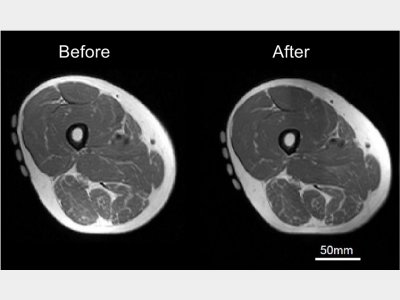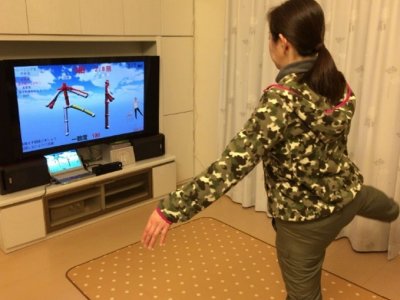Development of VR-assisted Support System for Exercise Training


Naokata Ishii
Graduate School of Arts and Sciences
Professor / Sports Science Initiative Director
※ Finished
Maintaining and/or improving our locomotive function are essential for extending our healthy life expectancy and preventing bed-ridden situations. In particular, an aging-induced decrease in muscle mass and strength (sarcopenia) has shown that it increases the risks of a fall, frailty and dementia in the elderly. We have developed a “low-intensity resistance training with slow movement and tonic force generation” (LST), which shows a considerable muscle-hypertrophic effect even when conducted at a low exercise intensity, thereby being useful for resistance exercise for the elderly and those people with diseases (Tanimoto & Ishii, 2006). In spite of the use of light load, the effect of LST is strongly influenced by the way of muscle activation, so that adequate instructions of exercise movement are indispensable. The current study aims to develop a virtual reality (VR) assisted support system for LST that makes everyone perform effective LST at home even if they cannot go to a gym or other facilities. Briefly, the exercise movement of the subject is recorded with a 3-D camera (Kinect) and wearable inertia sensors, and then real-time VR image is generated, displayed and superimposed on the model performance of an instructor. The subjects can improve the way of doing the exercise so as to match their own movement with the model performance. At present, we finished preliminary studies and are carrying out experiments for improving the accuracy of the system. This system will also be useful for “remote” instructions of a variety of physical performances other than LST.
Maintaining and/or improving our locomotive function are essential for extending our healthy life expectancy and preventing bed-ridden situations. In particular, an aging-induced decrease in muscle mass and strength (sarcopenia) has shown that it increases the risks of a fall, frailty and dementia in the elderly. We have developed a “low-intensity resistance training with slow movement and tonic force generation” (LST), which shows a considerable muscle-hypertrophic effect even when conducted at a low exercise intensity, thereby being useful for resistance exercise for the elderly and those people with diseases (Tanimoto & Ishii, 2006). In spite of the use of light load, the effect of LST is strongly influenced by the way of muscle activation, so that adequate instructions of exercise movement are indispensable. The current study aims to develop a virtual reality (VR) assisted support system for LST that makes everyone perform effective LST at home even if they cannot go to a gym or other facilities. Briefly, the exercise movement of the subject is recorded with a 3-D camera (Kinect) and wearable inertia sensors, and then real-time VR image is generated, displayed and superimposed on the model performance of an instructor. The subjects can improve the way of doing the exercise so as to match their own movement with the model performance. At present, we finished preliminary studies and are carrying out experiments for improving the accuracy of the system. This system will also be useful for “remote” instructions of a variety of physical performances other than LST.
Research collaborators
- Atsushi Hiyama (Lecturer, Research Center for Advanced Science and Technology)
- Shinsuke Yoshioka (Associated Professor, Graduate School of Arts and Sciences)
- Kuniaki Kaga (Mitsubishi Chemical Holdings, Tikyu Kaitekika Institute)
- Shinsuke Yoshioka (Associated Professor, Graduate School of Arts and Sciences)
- Kuniaki Kaga (Mitsubishi Chemical Holdings, Tikyu Kaitekika Institute)
Related publications
- Tanimoto, M. and Ishii, N. Effects of low-intensity resistance exercise with slow movement and tonic force generation on muscular function in young men. J. Appl. Physiol., 100, 1150-1157, 2006.
- Yamauchi, J., Mishima, C., Nakayama, S. and Ishii, N. Ageing related differences in maximum force, unloaded velocity and power of human leg multi-joint movement. Gerontology, 56, 167-174, 2010.
- Watanabe, Y., Tanimoto, M., Ohkane, A., Miyachi, M. and Ishii, N. Low-intensity resistance exercise with slow movement and tonic force generation increases muscle size and strength in older adults. J. Aging Phys. Activity, 21, 71-84, 2013.
- Watanabe, Y., Madarame, H., Ogasawara, R., Nakazato, K. and Ishii, N. Effect of very low-intensity resistance training with slow movement on muscle size and strength in healthy older adults. Clinl Physiol. Funct. Imaging, 34, 463-470, 2014.
- Watanabe, Y., Tanimoto, M., Oba, N., Sanada, K., Miyachi, M. and Ishii, N. Effect of resistance training using body weight in the elderly: comparison of resistance exercise movement between slow and normal speed movement. Geriatrics Gerontol. Int., 15, 1270-1277, 2015.
- Yamauchi, J., Mishima, C., Nakayama, S. and Ishii, N. Ageing related differences in maximum force, unloaded velocity and power of human leg multi-joint movement. Gerontology, 56, 167-174, 2010.
- Watanabe, Y., Tanimoto, M., Ohkane, A., Miyachi, M. and Ishii, N. Low-intensity resistance exercise with slow movement and tonic force generation increases muscle size and strength in older adults. J. Aging Phys. Activity, 21, 71-84, 2013.
- Watanabe, Y., Madarame, H., Ogasawara, R., Nakazato, K. and Ishii, N. Effect of very low-intensity resistance training with slow movement on muscle size and strength in healthy older adults. Clinl Physiol. Funct. Imaging, 34, 463-470, 2014.
- Watanabe, Y., Tanimoto, M., Oba, N., Sanada, K., Miyachi, M. and Ishii, N. Effect of resistance training using body weight in the elderly: comparison of resistance exercise movement between slow and normal speed movement. Geriatrics Gerontol. Int., 15, 1270-1277, 2015.
Contact
- Naokata Ishii
- Tel: +81-3-5454-6870/5465-7665
- Email: ishii[at]idaten.c.u-tokyo.ac.jp
※[at]=@









